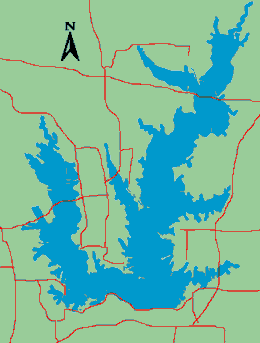Fishing
- Licenses & Regulations
- ShareLunkers
- Fish Identification
- Fish Consumption
- Texas Freshwater Fisheries Center
Water Resources
- Texas Reservoir Levels
- US Army Corps of Engineers
- Texas Water Issues
- Golden Alga
- Aquatic Vegetation
PO Box 1446
Pottsboro, Texas 75076
(903) 786-2389
Dan Bennett, Biologist
Local Information
- Lavon Area Chamber of Commerce
P.O. Box 356
Lavon, TX 75166
(972) 853-7092 - Wylie Chamber of Commerce
108-A West Marble
Wylie, Texas 75098
(972) 442-2804
Nearby State Parks
Lake Lavon
Quick Links: Fishing Regulations | Angling Opportunities | Cover & Structure | Tips & Tactics
BOATER ADVISORY: Zebra mussels have invaded this reservoir! CLEAN, DRAIN AND DRY your boat, trailer, livewells/bait buckets, and other gear before traveling to another water body. Draining water is required by law and possession and transport of zebra mussels is illegal.
Lake Characteristics
Location: In Collin County northeast of
Dallas and 4 miles northeast of Wylie, off Texas Highway 78
Surface area: 21,400 acres
Maximum depth: 59 feet
Impounded: 1953, reservoir size doubled
1974
Water Conditions
Current Lake Level
Conservation Pool Elevation: 492 ft. msl
Fluctuation: Moderate
Normal Clarity: Moderate, greenish
color
Reservoir Controlling Authority
US
Army Corps of Engineers
3375 Skyview Drive
Wylie, Texas 75096
(972) 442-3141
Aquatic Vegetation
Native emergent vegetation includes water willow and floating American lotus is present.
Predominant Fish Species
Lake Records
Current
Fishing Report
Stocking History
Latest Survey Report
Lake Maps
Free maps are available at the USACE office (972) 442-3141
Fishing Regulations
Statewide bag and size limits apply to all fishes on this lake.
Angling Opportunities
This lake is noted for crappie fishing, especially in winter and spring. Largemouth bass, channel catfish, and blue catfish offer good angling opportunities. Sunfish are plentiful, with good populations of several species.
| Species | Poor | Fair | Good | Excellent |
|---|---|---|---|---|
| Largemouth Bass | ||||
| Blue Catfish | ||||
| Channel Catfish | ||||
| Crappie | ||||
| White Bass | ||||
| Sunfish |
Fishing Cover/Structure
Most structure in this lake is in the form of standing timber, especially uplake in the East Fork Trinity River arm and the Sister Grove/Pilot Grove Creek arm. When present, aquatic vegetation is generally in the backs of the many small bays and coves along both sides of the two main arms running north and south. Infrequent stands of cattail surrounded by water can provide excellent habitat for most species. Outflow from the electric generating plant on the east side of the east arm can attract fish in winter, when ambient water temperatures dip. Rip-rap along the dam provides excellent habitat for largemouth bass, channel catfish, and sunfish.
Tips & Tactics
During the winter, crappie school in deep water and are usually found around deep structure, especially on south-facing shorelines. Some anglers place brush piles in deep water near boat houses for winter fishing. In the spring, these fish migrate into shallow water to spawn and become very vulnerable to angling. Baits of choice would be jigs and minnows. In winter, a very small (1/32 oz) black and white jig can be effective. In spring, try a 1/16 ounce chartreuse and red, chartreuse, white, or yellow jig. Largemouth bass are most active in spring when they move in shallow to spawn. Carolina-rigged 6-inch lizards, Texas-rigged 7-inch worms, and some crankbaits pay off here. The second peak occurs in the fall when bass begin actively feeding for the onset of winter. Try white spinners with gold blades in 3 feet to 1 ½ feet of water, or crawfish-mimicking crankbaits.
Channel catfish angling is best in the early summer when fish head up tributary streams to spawn or get in the rip-rap along the dam. Try cut bait, shrimp, or stink bait fished still or dragged along the bottom with the wind; also known as drift fishing. Blue catfish bite best in the winter and the bait of choice is live shad or sunfish. Drift fish deep, open-water points.
White bass provide lots of recreational angling most of the year, but peak in the spring when tributaries are running and in summer off the dam in deep water. In summer they are usually feeding on surfacing shad. Use small jigs, topwater baits, or minnows. Sunfish are best caught in shallow water while fishing from the bank, boat house, or pier. The bait of choice is the plain old earthworm.
